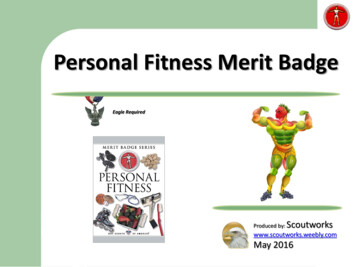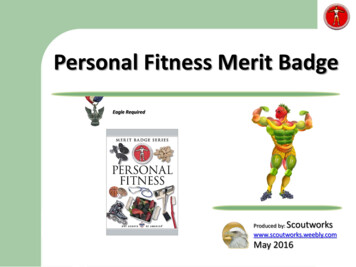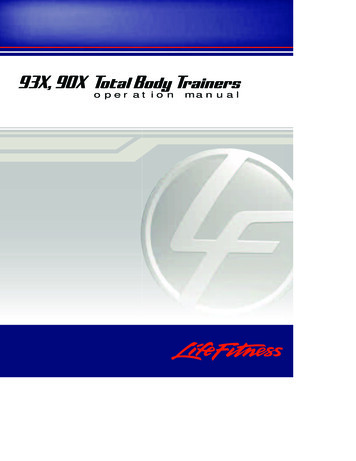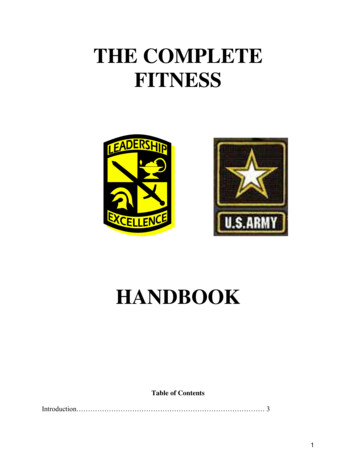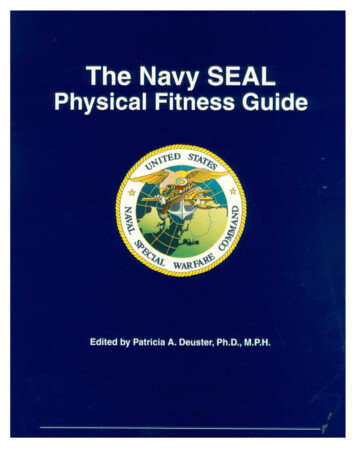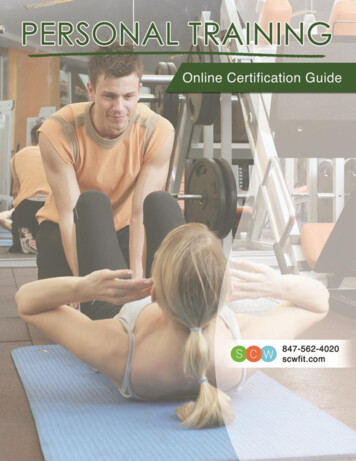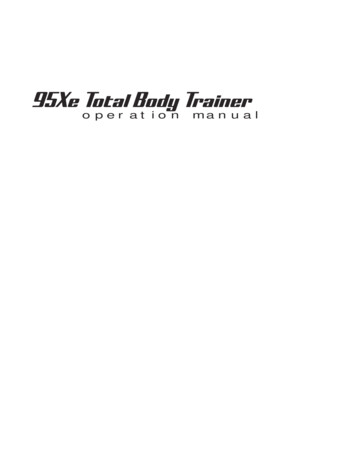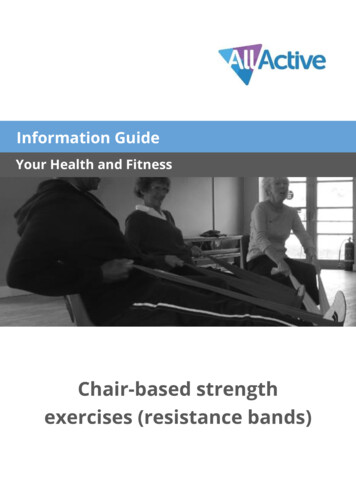
Transcription
Information GuideYour Health and FitnessChair-based strengthexercises (resistance bands)
What this guide is aboutMaintaining a minimum amount of muscular strength is essential for performing a widerange of everyday activities as you get older. However, strength decreases with age strength training can help to combat this loss, keeping you active and independent.Strength training is performed after a thorough warm-up, and is followed by a cool-down.Please see the following information guide for information on creating your own chairbased exercise workout to see where strength exercises fall within it: Building your own chair-based exercise session.Strength training does not need to be done on expensive resistance machines or by liftingheavy weights. You do not have to go to a gym to do them either. You can do strengthtraining at home, sitting down on a sturdy chair, with little or no equipment. In thisinformation guide we are using resistance bands, but we have produced other freeinformation guides showing strength exercises using weighted balls, dumbbells, and withno equipment at all.“Frailty is not a contraindication to strength training but conversely one of the mostimportant reasons to prescribe it” (ACSM, 2014)This AllActive information guide had been prepared by Amacsports Ltd and containsgeneral advice only. It should not be relied on as a basis for a substitute for professionalmedical advice.Amacsports does not accept any liability arising from its use and it is the reader’s soleresponsibility to ensure any information is up to date and accurate.AllActive is a registered trade mark of Amacsports Ltd.Date of publication: December 2015 Amacsports Ltd2 Chair-based strength exercises (resistance bands)
ContentsHow much strength training should I do? . 4Seated Posture . 61.Wrist squeeze, twist and pull . 72.Arm curl. 83.Tricep kickbacks . 94.Shoulder squeezes . 105.Chest press . 116.Seated row . 127.Seated abductors . 138.Leg press . 14Links . 153 Chair-based strength exercises (resistance bands)
How much strength training should I do?The Department of Health (2011) recommend adults (19 to 64 years) and older adults(65 years) should carry out physical activity to improve muscular strength on at least twodays a week.The American College of Sports Medicine, or ACSM for short, developed these guidelinesfurther. In the table below you will find their 2014 recommendations for strength trainingfor both adults and older adults:Frequency(how often)Each major muscle group should be trained on 2-3 days every week,so that any single muscle group has at least 48 hours rest betweenstrength training sessions.For adults: Moderate-intensity strength training (60-70% of 1RM) isrecommended for novice and intermediate adults to improvestrength.Vigorous-intensity strength training (80% or more of 1RM) isrecommended for experienced adults to improve strength.For older adults:Intensity(how hard) Light-intensity strength training (40-50% of 1RM) is suitable forolder adults starting strength training.Moderate-intensity strength training (60-70% of 1RM) isrecommended to improve strength.Progress as tolerated to vigorous-intensity (80% of 1RM).If repetition maximums are not measured, resistance intensity isdetermined using the 0-10 scale (see page 5 of this pack).On this scale, if a rating of 5-6 (‘somewhat hard’) is given, this equatesto moderate intensity, and a rating of 7-8 (‘hard’) denotes vigorousintensity.No specific duration for strength training has been identified. Weshould perhaps substitute ‘time’ for ‘volume’ (how much) here:Time (how long) 2-4 sets of 8-12 repetitions each are recommended to improvestrength in most adults.1 or more sets of 10-15 repetitions each are recommended forolder adults.Exercises involving each major muscle group should be performed.Type(what to do)A wide variety of exercise equipment (such as resistance bands,dumbbells, weighted balls, and resistance machines) and/or bodyweight exercises can be used to improve strength.11IRM stands for I Repetition max. This is the maximum amount of weight you can lift once only.4 Chair-based strength exercises (resistance bands)
5 Chair-based strength exercises (resistance bands)
Seated PostureThere are a lot of key points toremember here. Do not worry aboutremembering them all at once –focus on a couple each time youexercise and they will soon becomea habit.Feedback from another person orfrom looking at yourself in a mirroris a good way of checking andimproving your seated posture.6 Chair-based strength exercises (resistance bands)
1. Wrist squeeze, twist and pullPurpose: This will strengthen muscles in the forearms and improve grip strength.Squeeze: Roll or fold the resistance band into a tube and hold it vertically at stomach orchest height by grasping it with one hand on top of the other. Squeeze the band as tightly as possible for up to five seconds before releasing.Squeeze/twist and pull: This can be performed in a variety of ways. Perform as above, but with one or more of the following variations:oSqueeze and then pulloSqueeze and then twist.oTwist and pull.oSqueeze, twist and pull.oHold the band horizontally and perform any of the above.7 Chair-based strength exercises (resistance bands)
2. Arm curlPurpose: This will strengthen the muscles on the front of the arms.Instructions: Hold the band in your right hand, with the other end securely trapped underyour feet. Fix the right elbow into your ribs and rest the right hand by the right thigh withthumb uppermost. Bend the right arm up towards the shoulder (pulling the band taut), making surethe wrist is kept rigid throughout. Lower back down under control. After a few repetitions, repeat on the left arm.8 Chair-based strength exercises (resistance bands)
3. Tricep kickbacksPurpose: This will strengthen the muscles on the back of the arms.Instructions: Hold the band in your right hand, with the other end securely trapped underyour feet. With your right arm hanging down at the side, grasp the band with thumbuppermost and palm facing the chair. Keeping your chest lifted and right arm close to the body, pull the band upwardsuntil your elbow points backwards. From this position, straighten your arm, pause, and then let it bend once again. After a few repetitions, repeat on the other arm.9 Chair-based strength exercises (resistance bands)
4. Shoulder squeezesPurpose: This will strengthen muscles in your upper back.Instructions: Lay the band across your thighs, and grasp it with palms face-up and little fingerstouching. Keeping elbows fixed into your sides, pull the band apart, squeezing yourshoulder blades together as you do so. Release tension on the band, and return to the starting position.10 Chair-based strength exercises (resistance bands)
5. Chest pressPurpose: This will strengthen muscles of the chest and back of the arms.Instructions: Wrap the band around your middle back and thread each end under yourarmpits, holding them in each hand - your hands should start by the side of yourchest. Press both hands forwards until the arms are straight (but do not lock yourelbows). Squeeze your shoulder blades together as you pull your hands back to yourchest.11 Chair-based strength exercises (resistance bands)
6. Seated rowPurpose: This will strengthen muscles on your back and also on the front of your arms.Instructions: Straighten your left leg and loop the band around it, holding an end in eachhand, palms facing each other (with arms straight). Keeping the elbows down throughout, pull your hands towards your ribs - yourelbows should skim your body as you do this. Return to the starting position.12 Chair-based strength exercises (resistance bands)
7. Seated abductorsPurpose: This will strengthen muscles on the side of the hip.Instructions: Start with knees touching and feet slightly apart. Wrap a band once or twice around your thighs, and hold it securely in place withboth hands. Keep feet on the floor and stretch the band by spreading the knees further apartas far as you can comfortably. Hold, and then return to the start position.13 Chair-based strength exercises (resistance bands)
8. Leg pressPurpose: This will strengthen your thigh muscles and your bottom.Instructions: Straighten your right leg out in front, resting the heel on the floor so toes pointupwards - wrap the resistance band around the ball of this foot. Grasp the band either side of the knee, and then lift the knee whilst pulling thehands back to the hips. Keeping the hands fixed into the hips, straighten the knee until the heel of theright foot just touches the floor (the photo shows a harder version where thefoot remains raised throughout). Pause, and then bend the right leg. After several repetitions, repeat on the left leg.14 Chair-based strength exercises (resistance bands)
LinksAmerican College of Sports Medicine, and Pescatello, L. S. (2014). ACSM's guidelines forexercise testing and prescription. Philadelphia: Wolters Kluwer/Lippincott Williams &Wilkins Health.American College of Sports Medicine, and Swain, D. P. (2014). ACSM's resource manualfor guidelines for exercise testing and prescription. Philadelphia: Wolters KluwerHealth/Lippincott Williams & Wilkins.Department of Health (2011) Start Active, Stay icers15 Chair-based strength exercises (resistance bands)
Please don’t throw this guide away when you havefinished with it; perhaps pass it on to a friend, healthprofessional or to your local GP surgery.More free information guides can befound at www.allactive.co.ukAmacsports Ltd, 2 Denne Hill Business Centre, Womenswold, Canterbury, Kent, CT4 6HDwww.allactive.co.uk info@allactive.co.ukRegistered in England no. 04779660
7 Chair-based strength exercises (resistance bands) 1. Wrist squeeze, twist and pull Purpose: This will strengthen muscles in the forearms and improve grip strength. Squeeze: Roll or fold the resistance band into a tube and hold it vertically at stomach or chest
